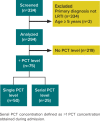Association of Procalcitonin Value and Bacterial Coinfections in Pediatric Patients With Viral Lower Respiratory Tract Infections Admitted to the Pediatric Intensive Care Unit
- PMID: 30697132
- PMCID: PMC6336174
- DOI: 10.5863/1551-6776-23.6.466
Association of Procalcitonin Value and Bacterial Coinfections in Pediatric Patients With Viral Lower Respiratory Tract Infections Admitted to the Pediatric Intensive Care Unit
Abstract
Objective: Our primary objective was to determine the utility of procalcitonin (PCT) in detection of bacterial coinfection in children < 5 years admitted to the pediatric intensive care unit with viral lower respiratory tract infection (LRTI).
Methods: Electronic medical record review of children < 5 years admitted to the pediatric intensive care unit with a viral LRTI who also had at least 1 PCT concentration measurement.
Results: Seventy-five patients were admitted to the intensive care unit and met the inclusion criteria for this investigation. The PCT threshold concentrations of 0.9, 1, 1.4, and 2 ng/mL were found to be statistically significant in determining the presence of a bacterial coinfection. The PCT concentration with the most utility was 1.4 ng/mL with sensitivity, specificity, positive and negative predictive values of 46%, 83%, 68%, and 76%, respectively. For patients with serial PCTs, the second PCT correctly influenced treatment decisions for 11 of 25 patients (44%).
Conclusions: A PCT value of 1.4 ng/mL determined the presence of a bacterial coinfection primarily owing to the high specificity and negative predictive value. Our data add evidence to the relatively high negative predictive value of PCT concentrations in identifying patients with bacterial coinfection, specifically in the case of viral LRTI. In addition, our preliminary data indicate serial PCT measurements may help further influence correct treatment decisions. Prospective, controlled studies are warranted to validate an appropriate PCT threshold concentration to help in identifying bacterial coinfection as well as to further explore the role of serial PCT values in determining the absence or presence of a bacterial coinfection.
Keywords: lower respiratory tract infection; pediatric; procalcitonin.
Conflict of interest statement
Disclosures Dr Cies is a consultant for Atlantic Diagnostic Laboratories and has received grants and/or honoraria from Allergan, Merck, and Thermo Fisher Scientific. The other authors declare no conflicts or financial interest in any product or service mentioned in the manuscript, including grants, equipment, medications, employment, gifts, and honoraria. This work was supported by a grant from Thermo Fisher Scientific. The authors had full access to all the data and take responsibility for the integrity and accuracy of the data analysis.
Figures
Similar articles
-
Procalcitonin to predict bacterial coinfection in infants with acute bronchiolitis: a preliminary analysis.Pediatr Emerg Care. 2014 Jan;30(1):11-5. doi: 10.1097/PEC.0000000000000026. Pediatr Emerg Care. 2014. PMID: 24365727
-
Association of procalcitonin values and bacterial infections in pediatric patients receiving extracorporeal membrane oxygenation.Perfusion. 2018 May;33(4):278-282. doi: 10.1177/0267659117743806. Epub 2017 Nov 18. Perfusion. 2018. PMID: 29153041
-
The Use of Procalcitonin for Prediction of Pulmonary Bacterial Coinfection in Children With Respiratory Failure Associated With Viral Bronchiolitis.Clin Pediatr (Phila). 2019 Mar;58(3):288-294. doi: 10.1177/0009922818816432. Epub 2018 Dec 14. Clin Pediatr (Phila). 2019. PMID: 30547669
-
The efficacy of procalcitonin as a biomarker in the management of sepsis: slaying dragons or tilting at windmills?Surg Infect (Larchmt). 2013 Dec;14(6):489-511. doi: 10.1089/sur.2012.028. Epub 2013 Nov 25. Surg Infect (Larchmt). 2013. PMID: 24274059 Review.
-
Using procalcitonin-guided algorithms to improve antimicrobial therapy in ICU patients with respiratory infections and sepsis.Curr Opin Crit Care. 2013 Oct;19(5):453-60. doi: 10.1097/MCC.0b013e328363bd38. Curr Opin Crit Care. 2013. PMID: 23817026 Review.
Cited by
-
Incidence and association of ocular manifestations with the disease severity in COVID-19 patients of northern region of India.Taiwan J Ophthalmol. 2022 May 19;12(3):312-316. doi: 10.4103/tjo.tjo_12_22. eCollection 2022 Jul-Sep. Taiwan J Ophthalmol. 2022. PMID: 36248072 Free PMC article.
-
Ocular manifestations of coronavirus disease 2019.Graefes Arch Clin Exp Ophthalmol. 2020 Sep;258(9):1959-1963. doi: 10.1007/s00417-020-04777-7. Epub 2020 Jun 6. Graefes Arch Clin Exp Ophthalmol. 2020. PMID: 32504100 Free PMC article.
-
Low Levels of Procalcitonin Are Related to Decreased Antibiotic Use in Children Hospitalized Due to Influenza.Diagnostics (Basel). 2022 May 5;12(5):1148. doi: 10.3390/diagnostics12051148. Diagnostics (Basel). 2022. PMID: 35626302 Free PMC article.
-
Methodology and application of multiplex PCR-dipstick DNA chromatography for the detection of eight respiratory bacterial pathogens.Front Cell Infect Microbiol. 2025 May 27;15:1558612. doi: 10.3389/fcimb.2025.1558612. eCollection 2025. Front Cell Infect Microbiol. 2025. PMID: 40496013 Free PMC article.
-
Serum Procalcitonin as a Predictive Biomarker in COVID-19: A Retrospective Cohort Analysis.Cureus. 2022 Aug 9;14(8):e27816. doi: 10.7759/cureus.27816. eCollection 2022 Aug. Cureus. 2022. PMID: 36106293 Free PMC article.
References
-
- Greenbaum AH, Chen J, Reed C et al. Hospitalizations for severe lower respiratory tract infections. Pediatrics. 2014;134(3):546–554. - PubMed
-
- Ralston SL, Lieberthal AS, Meissner HC. Clinical practice guideline: the diagnosis, management, and prevention of bronchiolitis. Pediatrics. 2014;134(5):e1474–e1502. - PubMed
-
- Hishiki H, Ishiwada N, Fukasawa C et al. Incidence of bacterial coinfection with respiratory syncytial virus bronchopulmonary infection in pediatric inpatients. J Infect Chemother. 2011;17(1):87–90. - PubMed
LinkOut - more resources
Full Text Sources
Miscellaneous


